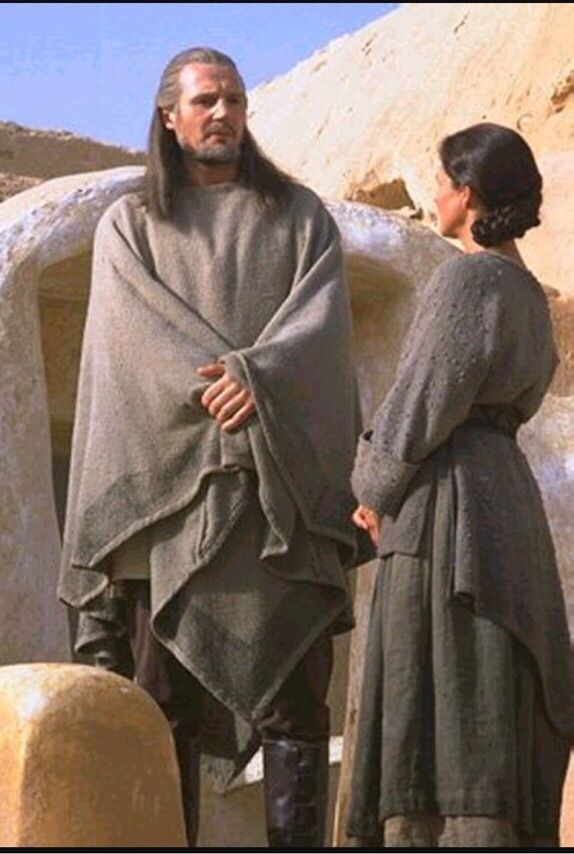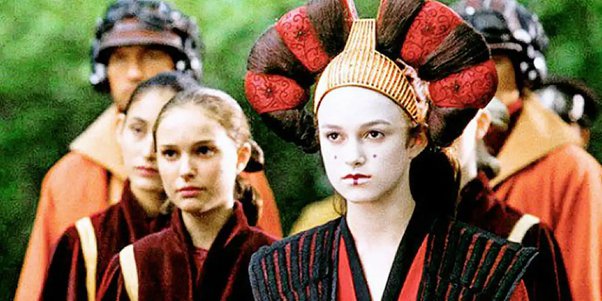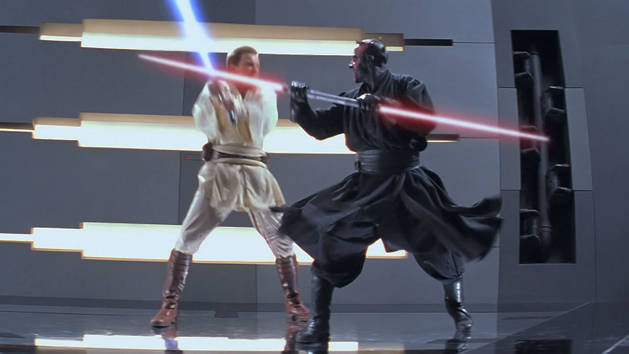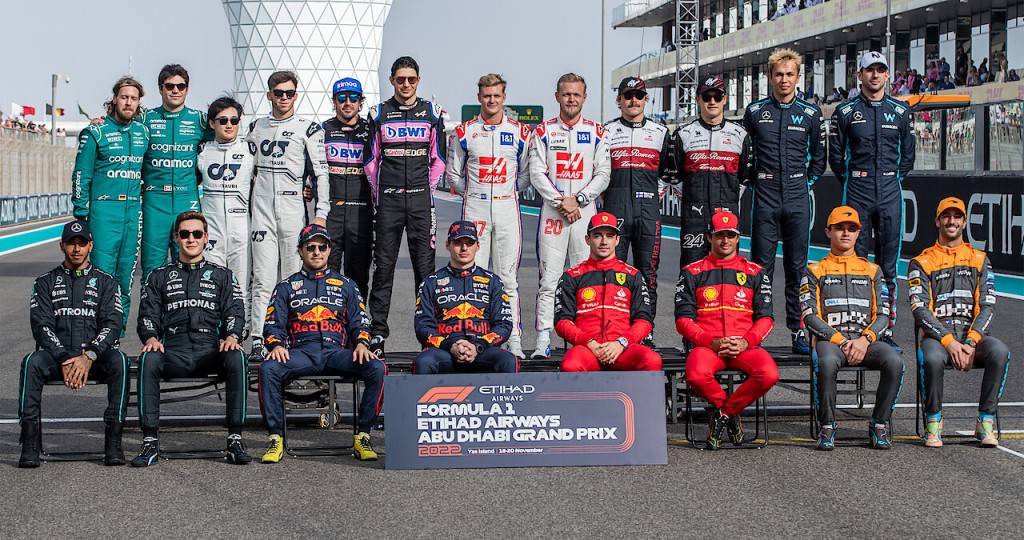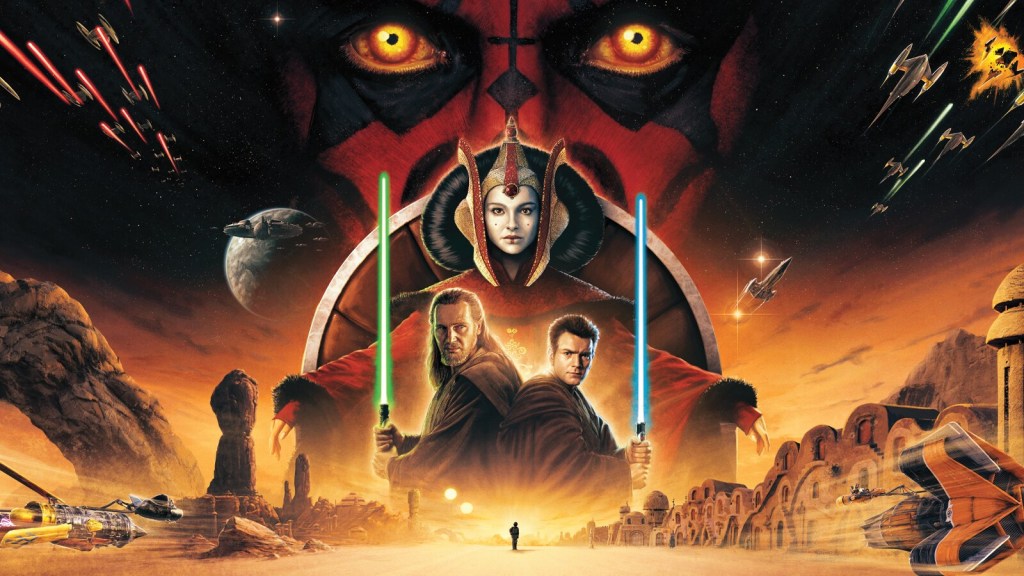
Every year I am met with more anniversaries that make my head spin. The last good X-Men movie came out a decade ago this month. Star Wars: Episode II – Attack of the Clones turned twenty years old two years ago. Star Wars: Episode I – The Phantom Menace makes 25 this weekend and can rent cars without hassle.
It is an imperfect but beloved movie, reassessed by some of its past decriers as the trilogy’s metaphor for American imperialism and the slide from liberalism to fascism becomes ever more cogent, sometimes held in unalloyed regard by those who enjoyed it as children. I am not quite one of those. I have a vivid memory of quitting on Episode III specifically while watching it on DVD on my original X-Box. I remember being embarrassed at the battle droid voices in the midnight screening before that.
The Phantom Menace is one of two Star Wars movies I do not believe I have ever seen in a theater (the other being the 1977 original). But I have seen it several times, and in honor of the 25th anniversary of its release, I thought I would share some thoughts:
I would have argued in the 2010s Star Wars as a whole and the prequels specifically could have done without the Phantom Menace. Setting aside the racist caricatures and awkward writing and performances in the films, there’s a decade between The Phantom Menace and Attack of the Clones, as opposed to the more reasonable three years between Attack of the Clones and Revenge of the Sith. It felt like an unforced error, starting us so far away from the main action, ending the trilogy with a gap of twenty years still between the trilogies. Maybe you start with Anakin as a Jedi child, and focus the films on his growth that way. Instead, he is part of an ensemble in the first film; Obi-Wan Kenobi (Ewan MacGregor) ends up the main protagonist of the trilogy (which is also interesting, especially in the second film where we see how much more interested he is in the adventuring part of being a Jedi than the tutelage part, though he maintains some joy in condescension toward Anakin). Spin-off shows filling gaps notwithstanding, it makes sense that the prequel trilogy is not just charting Anakin’s fall, but Obi-Wan’s life and Sheev Palpatine’s rise to power. Anakin is just a part of the story. Leaving the gap of twenty years is a creative choice that leaves a lot of space for interpretation but overall conveys a sense that there are twenty years of depression and stagnation across the galaxy. Still doesn’t make sense that the Death Star is so close to being finished at the end of Revenge of the Sith and only just starting to be used regularly in A New Hope, but such is life.
The Star Wars prequels are simultaneously an episodic melodrama about government corruption and a criticism of the uncritical worship of characters and stories by fans, wrapped in a shiny CGI-laden toy-selling bow for children. The Phantom Menace is a valuable artistic artifact of its time, beginning the political metaphor that carried through the Prequels and, as an example of both Lucas’s idiosyncratic style and digital mass-audience feature, showing how Hollywood began closing the door on individual acts of expression on large scale while committing further to the blockbuster model.
It’s also a jarring film if your last exposure to Star Wars is 1983’s Return of the Jedi. It is aesthetically several steps away from that film – its imagined science fiction universe much sleeker and more ornate. That’s in part because of different technological priorities in the production, but it’s also a tool for delivering a different perspective. The Star Wars prequels are less about war from the side of the warrior enmeshed in it and more from the side of the politician and the bureaucrat, if not the everyday citizen. The Jedi is reimagined, expanded from warrior monk to warrior monk-space cop, with all the subjective interpretation and application of laws and rules there implied.
My read on the prequels has gradually evolved to see it as George Lucas cutting the legs out from under fans’ hero worship of the Jedi (itself a silly phenomenon considering how often in the EU they were shown to be flawed before and after Luke’s new Jedi order) while creating a space opera for children about the tendency of liberal states to slide into fascism due to corporate capture of the state apparatus.
We learn in the Clone Wars cartoon that all the actual regulatory and enforcement bodies are atrophied and that the Senate hardly even pays the aids that work for it on Coruscant, but even with this first prequel film we see a trend that we’re reminded of in both of its sequels – the government is invested in its own largesse and maintaining ceremony but cannot help people at the margins. The government has overextended itself – the massive body of the Senate holds tens of thousands of representatives who cannot, by personal will or by government structure, facilitate a just society.
Watching The Phantom Menace, we’re introduced to capitol planet Coruscant by following a random spaceship navigating traffic and coming down into the planet’s atmosphere, and as we come to see Darth Maul and a figure who looks like The Emperor (and turns out to be Senator Palpatine, played in either case by Ian McDiarmid) conversant, we get a sense of the massive scale of the planet. There are thousands of levels of people on Coruscant – trillions of people. Small delegations in the legislature represent single planets or whole systems in different sectors of the galaxy, with voting representative delegations for banking clans, trade federations, and mining guilds.
Speaking of Sheev’s rise to power, one thing that really struck me on this most recent watch was the vast scale of the planet of Coruscant; in the second film, it reminds more of Blade Runner, but in The Phantom Menace it feels like Metropolis. It’s so big; the daytime scenes where you see the Senate building evoke tremendous scale. It’s a massive high-rise among high rises, dwarfing the many ships that fly past it.
Zooming in on the Jedi, their arrogance is on full display as they use mind tricks to maneuver every situation, flouting rules and norms as suits them. The casual cruelty inherent to their organization also apparent in the freedom/abduction of Anakin Skywalker. The boy who would become Vader is a slave; the Jedi free him because he is useful. They cannot free his mother without disrupting the order of things on Tattooine – don’t have the inclination to start a slave rebellion, even in the future once the conflict of the story is resolved. That he would hold onto such concerns is considered a sign of his weakness and hotheadedness. But, back to the film at hand, it’s said that he’s too old to begin the training, because of these attachments to his mother, this past he will not be able to forget as he executes his Jedi duties.
The Jedi Temple, which we see much more of in the following films, has its own strange look to it, but what matters there is the characters. There’s the Yoda-like lady Jedi Yaddle, who has no lines, disappears after this movie, and was not replaced with CGI in the remastering like Yoda was. More pressing is Samuel L. Jackson’s Mace Windu, stoic with anger in his eyes, certain of Anakin’s potential but not interested in training him. I wonder, what happened to people the Jedi found out in the galaxy that they did not adopt into their order; shouldn’t they want to prevent just having loose Force users out and about? Potential Sith, as it were…
Liam Neeson’s Qui-Gon Jinn as a character is a retcon that throws a wrench into Yoda and Obi-Wan’s previous relationship (Obi-Wan had told Luke that Yoda was the Jedi who instructed him). Midichlorians felt like an unnecessary scientific codification for the mystical ubiquity of the Force. More importantly, though, Jinn’s literal interpretation of Shmi Skywalker’s words about Anakin not having a father and the Jedi’s related “Chosen One” prophecy helped set up half of the political inquiry of the Star Wars prequels. It’s canonical that Anakin was made through the Force by Palpatine, instead of something more interesting and human like Shmi having an ill-fated relationship; I suppose this magical conception is preferable to implications of a slave suffering sexual violence in a children’s movie, but you know what else would have been interesting? If the chemistry between Shmi and Qui-Gon was evidence of an old tryst; if Anakin was Qui-Gon’s long lost lovechild and that’s why he was so intent on freeing and training him, underscoring the cruelty (or learned hopelessness) of leaving Shmi to her fate.[1]
Anakin’s arc over the films is fascinating – the Jedi need him and they use him, but they never trust him despite foisting the responsibility of a millennia-old prophecy and command of clone soldiers upon him. My read is that the prophecy was bullshit: in the third film, George Lucas introduces some ambiguity (notwithstanding whatever J.J. Abrams was trying to do in the climax to The Rise of Skywalker) about the prophecy, some doubt by Yoda about how they interpreted it to begin with. Mace Windu only starts to come around to the kid when they go to arrest Palpatine.
It’s obvious to everyone in the Jedi and the government that Anakin is sleeping with (secretly married to) a powerful(?) Senator, but no one broaches the topic and he thinks it’s forbidden, never has anyone he can entrust with his concerns about her dying. The few times he tries, in veiled language, to go to the Council for help, they fail him. “Train yourself to let go of everything that you fear to lose,” says Yoda, not realizing he’s doomed the Jedi Order and the Republic. Anakin’s main father figure never wanted him and has always treated him snidely as if resentful that Qui-Gon Jinn put the kid in his lap. Obi-Wan trained Anakin because he owed Qui-Gon and wanted to honor his memory, he grew to love the man, to be his friend, but in many ways, like he says at the end of the trilogy, he failed Anakin.
One of the clever, silly things they do in The Phantom Menace is have Natalie Portman play Padme, Queen Amidala’s handmaiden and bodyguard (secretly the queen) while Keira Knightley plays Queen Amidala (secretly her handmaiden and bodyguard Sabé). It strikes me watching the film now that the films would have a different narrative and political trajectory if Padme had really been the handmaiden and went on to become a Senator; i.e., if the films were about two young up-and-comers thrust into great power and responsibility.
Anakin (nine years old when fourteen year-old Padme meets him in The Phantom Menace) later marries Padme in a secret wedding at the end of Attack of the Clones. Five years his senior, she confessed her love to him as they were entering an arena to be killed. My read on this is that he was infatuated and she was sure they were about to die. The flirtation beforehand was like her letting off steam or having fun.
But, back to Phantom Menace. Funny tweets notwithstanding, it’s clear that their initial feelings are platonic. I mean, the nine-year-old might have a crush on the teenager, but I don’t think it goes both ways. I am curious about the idea of an elected queen; George Lucas seemed to want the titles, pomp, and circumstance that came with having a monarchy while telling his story about intergalactic democracy falling into fascism. What’s fascinating here, to me, is how a planet’s society develops in such a fashion that they determine that elected child monarchs are their best hope for just rule and – in the case of Amidala and Naboo – training for that person to become their representative in the Galactic Senate.
Palpatine, who I don’t believe was ever king, orchestrates a nomination to the Supreme Chancellorship from his position as Naboo’s senator, manipulating the Queen and her doppelganger to call for a vote of no-confidence for his predecessor, Valorum. In a blunt bit of storytelling, Valorum’s hand is stayed on an investigation of the Trade Federation’s blockade and invasion by bureaucrats standing alongside him whispering in his ear (likely about the Senate Parliamentarian or some such nonsense). Much like his later promise to Anakin (to teach him the trick to eternal life and resurrection), he does not repay the favor done to him, living his alleged allies (and in this case, his technical superior) twisting in the wind. He’s nominated, but not yet elected, so the Republic proper continues to offer no help to the people of Naboo. Amidala has lost faith in the Republic and returns home, falling into the future-Emperor’s trap. The Jedi Council orders Qui-Gon and Obi-Wan to return with Amidala, and Obi-Wan is trying to impress on Qui-Gon that he doesn’t think the boy should be trained because he’s dangerous. As aforementioned, this fear of Anakin’s potential for danger creates the danger; a real self-fulfilling prophecy.
The fighting between Amidala’s strike team and the battle droids feels somewhat passionate on one side, but inert on most of the other. One problem I had with the films from my younger days and maintain is true is that the war taking place between droids and clones removes a human element about the cost of war. There are other metaphors at play in the use of slave labor, indoctrination, and the connection between the finance industry and the military-industrial complex, though perhaps not smoothly.
I found Gungan exile funnyman Jar Jar Binks (Ahmed Best) generally less annoying on this watch than I have in some of the past. I generally found him amusing. I did find it funny that Qui-Gon’s attempt to use a mind trick on Boss Nass led to him sending them through the planet core – weak-minded enough to be open to persuade, but strong enough to still send them to their apparent deaths. Later Jar Jar is given a command for the sole reason that Nass thinks it will be funny if he dies on the front lines.
Jake Lloyd is fine as young Anakin. I think anyone who harassed him is a real piece of shit; the young lad gave up acting. Now, I don’t feel it was necessary to have a child protagonist for child hands to dig it. I wanted to be Luke as a child and we never see him younger than his late teens. However, in skewing the film younger, Lucas allowed the audience to grow with the characters. If you see The Phantom Menace at ten years old and then Revenge of the Sith at sixteen, you’re going to have a really engaging experience of learning about how storytelling works even if you’re not a kid that writes fan fiction or film reviews or whatever; just the subliminal process of understanding the story on a different level as a child than as an adolescent will be clarifying about your tastes. Anyway, the pod race sound design is fantastic, and it really stresses Anakin’s immense talent as an engineer and a mechanic that, at nine years old, he can build a racer to compete with professionals that travel the galaxy; such a good racing vehicle that, after he stalls out at the starting line, he’s able to come from behind and win the race from last position.[2]
The Duel of the Fates is a fun fight scene; I feel that the original films are still generally superior for emotional impact to those in the prequels, while the prequel films have much better choreography by and large.[3] But, Obi-Wan yelling “No!” as Qui-Gon is felled is a two-way narrative echo: in the real world, it echoes what we had already seen; in the universe of the films, it foreshadows Luke’s later experience seeing Obi-Wan die. In fact, while I don’t care for George Lucas deciding over the course of these films that learning to be a Force Ghost is a special technique you have to learn (I feel like it cheapens the spirituality by making it just a skill besides rendering a bunch of cool stuff more complicated before Disney rendered it noncanonical), Obi-Wan seeing this happen to Qui-Gon and being enraged by it before later giving up his own life peacefully (“If you strike me down, I will become more powerful than you can imagine) is meaningful without Qui-Gon teaching him to be a Force Ghost as a ghost, but it gains a wrinkle with that addition.
In the end, one of Padme Amidala’s security head Captain Quarsh Panaka (Hugh Quarshie) says the Trade Federation can “kiss their trade franchise goodbye,” setting up the plot of the next film. The Trade Federation is a founding member of the Confederation of Independent Systems, the “Separatists” or CIS. They don’t seem to have lost their ability to produce robot soldiers, thanks to the connections they make with the people of Geonosis. But they are eager to escape the control of the Republic. We know little of their inner lives, but they were the first pawns on the board for Sheev, the first moves he made and the central antagonists of this film while he manipulates from the darkness.
The thing that makes the prequels hard for some critical viewers is that they’re children’s films with a lot of adult themes. This is harder for adults than children because children don’t typically decide what is or isn’t appropriate for them. They don’t hear “trade federation” and “illegal blockade” and start worrying about the feasibility of intergalactic trade or asking an accountant or comptroller to start fact-checking the film. All the information they need to figure out if they’re having a good time – and, indeed, all a critic needs to know whether or not it’s a good movie – is take the information as given and apply it to the world as received. Any insights you have about the real world are only useful and applicable so far as they speak to the real world stimuli which George Lucas and his collaborators are responding to in the piece. Any real life insights about trade or politics that fly in the face of the universe are tertiary to the experience; to over-apply it is to at best mistake the metaphor and allegory for one-to-one recreation. Otherwise it’s sophistry and pedantry, isn’t it?
Feudalism is hard for kids to wrap their minds around but if you present them a film with a king, a tax collector, and a peasant, they can follow the story without a ledger or an abacus. They might miss that Palpatine is manipulating Amidala, but they migh tnot. They’re certainly capable of seeing the Jedi are treating Anakin unfairly and that he shouldn’t have had to leave his mother behind. Those things are textual.
I like the prequels more than I did the last time I watched them, and I’m really impressed that George Lucas was so willing to try things. Now we get family-targeted blockbusters on an annual schedule that feel like they have all their edges sanded off and undercut all their interesting choices or ideas. For all the subjective flaws of the Star Wars prequels, and the arguments that can be made over which story ideas could have been better executed, there were at least ideas at work and play here. They may just stand the test of time.[4]
[1] He even uses the Force to influence the die to make sure it lands on the color representing Anakin when their owner, Watto, won’t let him bet for them both.
[2] I jokingly compared it on Twitter/X to Sergio (“Checo”) Pérez falling into 18th during the Sakhir Grand Prix in 2020 and coming from behind to win the race. It was a great story on Drive to Survive, winning him a spot at Red Bull as he was pushed out of the Racing Point team that would eventually become Aston Martin. I don’t know who’s Lance Stroll in this picture, but I guess Qui-Gon is Christian Horner.
[3] (of course, there’s a huge step up in the fencing choreography between A New Hope and The Empire Strikes Back)
[4] Inevitably the Sequels will be reappraised and I’m not much looking forward to it. 7 is a remake of A New Hope, The Last Jedi is the most interesting and divisive so it may just be an unstoppable discourse-generating force for the next decade and a half, and The Rise of Skywalker is terrible but someone enjoyed it so someone will reclaim it as they get older. Because that’s how these things work. Critics and enthusiasts develop tastes within the context of a given childhood and adolescence and then even as their tastes change and grow some of that sticks to them and reoccurs.

